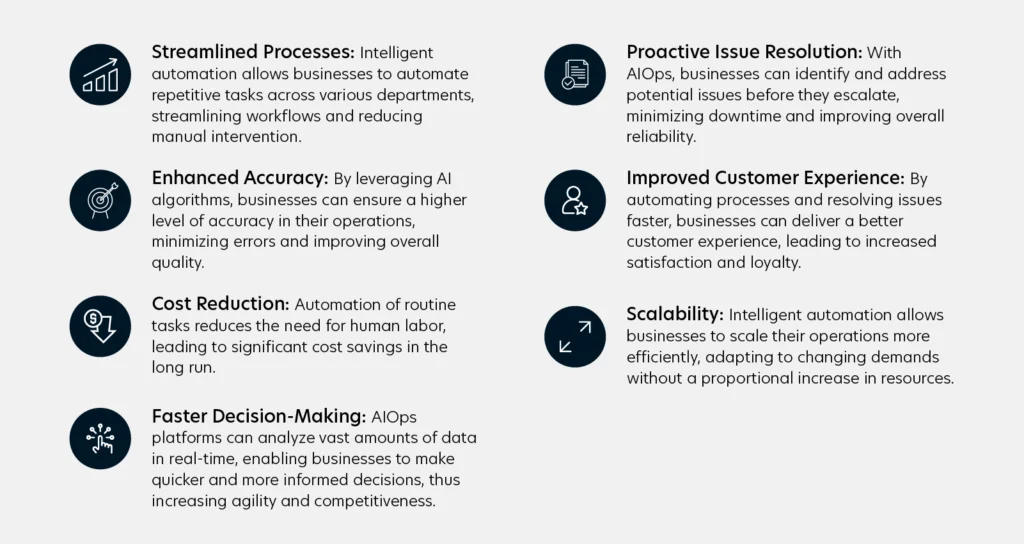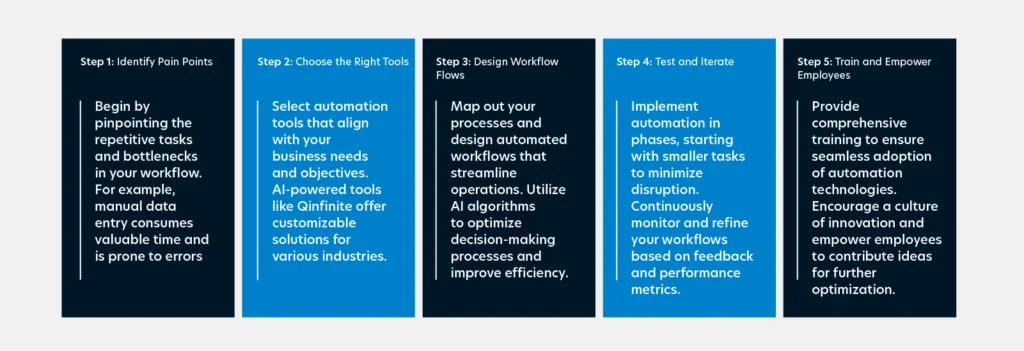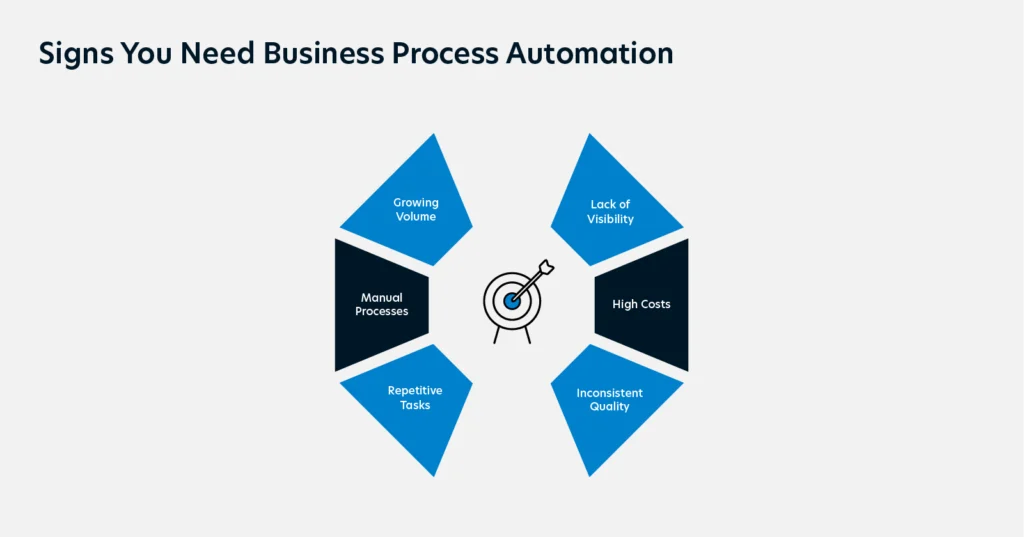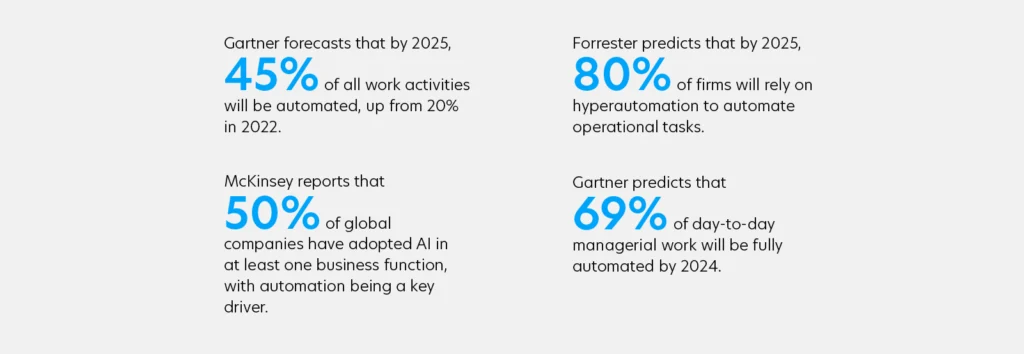The Evolution of Efficiency: How AI in Business Process Automation Is Changing the Game
Business process automation can boost performance with smarter automation solutions and can unlock AI potential for sustainable business growth
Read moreAutomation in IT operations enable agility, resilience, and operational excellence, paving the way for organizations to adapt swiftly to changing environments, deliver superior services, and achieve sustainable success in today's dynamic digital landscape.

The significance of AIOps for IT operations transformation lies in its ability to proactively resolve issues, enhance operational efficiency, and decision-making.
Next-generation application management fueled by AIOps is revolutionizing how organizations monitor performance, modernize applications, and manage the entire application lifecycle.
AIOps and analytics foster intelligence to optimize workflows, enhance service quality, and align IT operations with business goals.
Intelligent Automation is a cutting-edge technology that combines artificial intelligence and automation to streamline business processes, enhance efficiency, and drive cost savings. By integrating AI algorithms with automation tools, businesses can automate repetitive tasks, make data-driven decisions, and optimize operations like before.
According to an automation survey, organizations that have already moved beyond piloting intelligent automation achieved an average cost reduction of 32%.
Automation driven by Artificial Intelligence (AI), presents an unparalleled opportunity for businesses to revolutionize their operations, driving efficiency and cost savings to new heights. Here’s how:

Intelligent Automation (IA) holds the key to unlocking a new realm of efficiency and cost savings, propelling your business into the future. Are you feeling the pinch of missed opportunities despite investing heavily in cost-cutting and customer service excellence?
Don’t get left behind – Explore Quinnox’s ground-breaking AI-powered Platform, Qinfinite, and revolutionize your operations to thrive in the digital age.
Amidst the demands of rapid growth, complex processes often hinder efficiency, leading to bottlenecks and delays. How can businesses navigate these challenges and unlock their full potential? The answer lies in harnessing the power of workflow automation.
Quick Insight: According to a McKinsey report, automation could boost global productivity growth by up to 1.4% annually.
With the power of AI-driven automation, these challenges become growth opportunities. AI can analyze vast amounts of data, predict outcomes, and even optimize processes in real time, revolutionizing how businesses operate. So, how can you harness the potential of workflow automation and AI for your business?

By following these steps, businesses can unlock unprecedented agility and efficiency, paving the way for sustainable growth in the digital landscape. Embrace the power of workflow automation and propel your business into the future.
According to several reports, businesses that implement Business Process Automation see a 41% increase in productivity and a 35% reduction in costs.
Business Process Automation (BPA) is a transformative tool that enables organizations to streamline operations, enhance efficiency, and drive growth. By automating repetitive and manual tasks, BPA frees up resources, reduces errors, and improves productivity. But what if you could push efficiency even further? Here’s where Artificial Intelligence for IT Operations (AIOps) steps in.

When combined with BPA, AIOps can:
This powerful duo of BPA and AIOps empowers businesses to achieve:
This integration empowers businesses to move beyond simple automation towards intelligent process management, driving significant improvements in overall performance.
Business Automation, also referred to as Business Process Automation (BPA), employs technology to streamline and automate organizational processes and functions. This strategic implementation of technology facilitates significant productivity enhancements by converting manual processes into automated workflows spanning the entire organization.
Quick Insight: As per Gartner, the global BPA software market, worth $2.6 billion in 2022, is projected to grow to $3.6 billion by 2027.
Automation technology aids organizations in efficiently managing risk and compliance, ensuring adherence to standards and prompt adjustment of operational areas.
Unlike humans, with automated, errors within an organization are effectively eliminated
Quick Insight: As per Gartner, worldwide end-user spending on public cloud services is projected to exceed $1 trillion in 2027.
Cloud automation encompasses processes and tools designed to minimize or remove human involvement in managing cloud computing workloads and services, including tasks like automating cloud infrastructure, organizing compute resources, managing workflow versions, and conducting backups.
Automation simplifies the intricate task of configuring, testing, updating, and troubleshooting the vast network of resources, enhancing efficiency and scalability.
Deployments automatically adjust resource capacity based on workload fluctuations. For instance, during unexpected spikes in user traffic, the system scales up resources seamlessly, while scaling down during low demand to optimize cost-efficiency.
Cloud automation maintains a standardized base configuration across projects, minimizing misconfigurations and ensuring predictable access to resources.
Custom software enables seamless integration of modern enterprise applications into the existing system while prioritizing adherence to all security measures.
Data automation involves using technology and software to integrate and automate tasks and processes related to an organization’s data. Through algorithms, scripts, and tools, it automatically collects, processes, transforms, and analyzes (ETL) data, eliminating the need for manual human intervention.
Businesses can benefit greatly from Data Automation in the following ways-
Data automation enhances team efficiency and improves customer satisfaction by enabling prompt response and informed decision-making based on real-time insights.
With a stronger focus on generating fresh insights to support data-driven decision-making, automated data analytics saves businesses time and money with complete, high-quality, and up-to-date data.
Data Automation enhances performance and scalability by executing complex and time-consuming tasks efficiently.
DevOps automation is a key component of modern software development practices that aims to streamline and accelerate the deployment of code changes. By automating various stages of the development process, from coding and testing to deployment and monitoring, DevOps automation enhances efficiency, reduces errors, and enables teams to deliver high-quality software at a faster pace.
Quick Insight: As per latest reports, 90% of IT leaders believe that incorporating AIOps into DevOps and security projects is projected to significantly amplify the scope of DevSecOps in 2024 and beyond.
Artificial Intelligence (AI) is revolutionizing DevOps automation by introducing intelligent capabilities that enhance IT operations, including monitoring, incident management, and root cause analysis. Here are the benefits that AIOps brings to software development and operations:
Intelligent Monitoring: AIOps tools can provide predictive insights into application performance and infrastructure health, which can inform automated DevOps processes for quick resolution of issues and proactive maintenance.
Automated Remediation: By integrating AIOps capabilities into DevOps automation workflows, organizations can automate the identification of performance bottlenecks or anomalies and trigger remediation actions without human intervention, leading to improved system reliability.
Continuous Improvement: AIOps can analyze vast amounts of operational data to identify patterns and trends, which can be used to refine DevOps automation processes for continuous improvement and optimization.
Enhanced Decision-Making: AI-driven insights from AIOps can guide decision-making within DevOps teams, helping them prioritize tasks, allocate resources efficiently, and improve overall software delivery performance.
Automation software has emerged as a transformative force in modern businesses, revolutionizing traditional workflows and driving operational efficiency to new heights. By replacing manual, time-consuming tasks with automated processes, businesses across industries are reaping many benefits that directly impact their bottom line and competitive edge.
One of the primary advantages of automation software is the significant boost in efficiency it brings to organizations. By automating repetitive tasks, such as data entry, report generation, and customer communications, businesses can reallocate human resources to more strategic initiatives that require creativity and critical thinking. This shift not only increases overall productivity but also reduces the likelihood of errors, leading to higher-quality outputs and improved customer satisfaction.
Moreover, automation software offers businesses substantial cost savings by streamlining processes and reducing reliance on manual labor. By automating routine tasks, companies can achieve operational economies of scale, optimize resource allocation, and minimize overhead costs. This cost efficiency allows businesses to invest resources in innovation, research and development, and other growth-oriented initiatives that drive long-term success.
In addition to efficiency and cost savings, automation software provides businesses with a competitive edge by enhancing agility, scalability, and responsiveness to market dynamics. Automated workflows enable quicker decision-making, faster time-to-market for products and services, and greater adaptability to changing customer demands. This agility is crucial in today’s rapidly evolving business landscape, where the ability to pivot swiftly and seize opportunities can make all the difference between success and stagnation.
Enterprise automation refers to the use of software and technology to automate complex and repetitive manual processes across an organization. It’s essentially about leveraging technology to streamline how businesses function, boosting efficiency and productivity. This is where the integration of AIOps acts as the intelligent layer for enterprise automation, enabling a more streamlined and efficient IT environment by analyzing data, predicting problems, and automating responses.
AIOps platforms can analyze vast amounts of data from various sources, such as logs, metrics, and events, to detect anomalies, forecast potential issues, and recommend automated actions to prevent downtime or performance degradation. This predictive and prescriptive approach not only minimizes disruptions but also improves overall system reliability and availability.
Moreover, AIOps plays a crucial role in accelerating incident resolution and problem management within enterprise IT environments. By incorporating AI-driven algorithms and automation tools, AIOps platforms can categorize and prioritize incidents, correlate related events, and suggest resolution strategies based on historical data and patterns.

Operational Efficiency: Automation eliminates repetitive, manual tasks, allowing employees to focus on more strategic activities that require human intelligence and creativity. This leads to increased efficiency and productivity within the organization.
Cost Savings: By automating routine processes, businesses can reduce labor costs, minimize errors, and increase output without proportional increases in expenses. This cost efficiency contributes to improved profitability and resource optimization.
Improved Accuracy: Automation reduces the likelihood of human errors in data entry, calculations, and other repetitive tasks, leading to higher accuracy levels in outputs. This enhanced precision translates to better decision-making and higher-quality outcomes.
Enhanced Compliance: Automation ensures consistency in adhering to regulatory requirements and internal policies by standardizing processes. This minimizes compliance risks and helps maintain audit trails for accountability.
Scalability and Flexibility: Automated processes can scale according to business needs, accommodating fluctuations in workload and demand without compromising quality or efficiency. This scalability fosters business agility and adaptability in dynamic market environments.
According to recent statistics, AI automation is projected to generate substantial economic value for businesses across various sectors. A study by McKinsey estimates that AI-driven automation could contribute $13 trillion in additional global economic output by 2030, highlighting the immense potential of AI technologies to drive productivity gains and revenue growth. Moreover, research from PwC suggests that AI could increase the global GDP by up to 14% by 2030, emphasizing the transformative power of AI automation in catalyzing economic prosperity and organizational success.
The impact of AI-driven automation systems on businesses extends beyond operational efficiencies to strategic decision-making and market differentiation. By harnessing AI capabilities to automate routine tasks, analyze data at scale, and predict future trends, organizations can make informed decisions, optimize resource allocation, and identify new growth opportunities with precision and speed.
As businesses continue to embrace AI technologies and automation capabilities, they are poised to unlock untapped potential, drive innovation, and achieve sustainable growth in an increasingly digital and data-driven ecosystem. With the right strategic vision and investment in AI automation, businesses can position themselves as industry leaders, driving value creation, competitive differentiation, and long-term success in the evolving landscape of the Fourth Industrial Revolution.
In the realm of Information Technology (IT), automation has emerged as a game-changer, streamlining processes, enhancing efficiencies, and driving innovation across enterprises. One of the key advancements in this space is AIOps, a transformative approach that integrates AI and machine learning to optimize IT operations.
AIOps is revolutionizing how businesses manage their IT infrastructure, applications, and services by providing real-time insights, predictive analytics, and automated remediation capabilities. The impact of AIOps extends far beyond traditional IT operations, empowering organizations to proactively address issues, improve system performance, and enhance customer experiences.
Quick Insight: According to a report by Gartner, by 2023, 40% of enterprise IT teams will use AIOps platforms to enhance monitoring and management practices, emphasizing the growing importance of AIOps in driving operational excellence and digital transformation within organizations.
By harnessing AI-driven algorithms and automation tools for IT Automation, businesses can gain actionable insights from massive volumes of IT data, enabling proactive problem-solving and decision-making. Furthermore, AIOps enables IT teams to detect anomalies, identify patterns, and automate responses to incidents, minimizing downtime, optimizing resource allocation, and ensuring seamless service delivery.
With AIOps at the helm of IT operations, businesses can navigate the complexities of the digital age with confidence, driving sustainable growth, competitive differentiation, and long-term success in an era defined by rapid technological advancement and evolving customer demands.
Want more CX content? Check interesting blogs below!
Business process automation can boost performance with smarter automation solutions and can unlock AI potential for sustainable business growth
Read moreEmbracing cutting-edge automation technologies with top business process automation trends in 2024 and learn how hyperautomation can drive business innovation and efficiency
Read moreDrive automation with cloud cost optimization for effective resource utilization and improved efficiency
Read moreRequest a free demo of Qinfinite, your AI-powered next-gen platform for operational excellence.
Request Free Demo